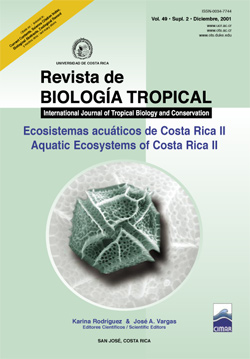Abstract
Few papers concerning seagrasses of the eastern Pacific have been published. This paper presents the first ecological data on the seagrass, Ruppia maritima, from a non-lagoonal setting in the eastern Pacific. A 5 000 m2 patch formed by R. maritima, at Playa Iguanita, Bahía Culebra, Pacific coast of Costa Rica was studied. Plant density and leaf length of R. maritima were determined along two transects on different dates. Above and below ground biomass were calculated along one transect. Plant density ranged from 1 590 to 8 630 individuals m-2 along the two transects, with means of 5 990 ± 1 636 and 6 100 ± 1 876 plants m-2 for transect 1 and 2, respectively. Longest leaf length per plant varied between 0.5 and 23.0 cm. Leaf biomass (LB) ranged from 10 to 97 gm-2, and root-rhizome biomass (RB) from 31 to 411 gm-2, resulting in RB:LB ratios of 3.07 to 15.27. Total biomass at Bahía Culebra was lower than at tropical lagoons on the Pacific coast of Mexico, but higher than in the Gulf of Mexico. The below ground: above ground biomass ratio was much higher at Bahía Culebra than at other sites on the Pacific coast of Mexico and the Gulf of Mexico. Another seagrass present at Bahía Culebra was Halophila baillonii, with low densities on the deepest section of the patch. At least 44 invertebrate species associated with the seagrass bed have also been identified. The patch at Playa Iguanita and other sites within Bahía Culebra, as well as their associated organisms, disappeared after a severe storm in June 1996. No seagrasses have been found in the area or in any other location on the Pacific coast of Costa Rica since then.References
Bird, K.T., J. Jewett-Smith & M.S. Fonseca. 1994. Use of in vitro propagated Ruppia maritima for seagrass meadow restoration. J. Coast. Res. 10: 732-737.
Davidse, G., M. Sousa S. & A.O. Chater (eds.) 1994. Flora Mesoamericana: Vol. 6. Alismataceae a Cyperaceae. Instituto de Biología, Universidad Nacional Autónoma de México, México, D.F. 543 p.
Dunton, K.H. 1990. Production ecology of Ruppia maritima L. s.l. and Halodule wrightii Aschers, in two subtropical estuaries. J. Exp. Mar. Biol. Ecol. 143: 147-164.
Edwards, R.R.C. 1978. Ecology of a coastal lagoon complex in Mexico. Estuar. Coast. Mar. Sci. 6: 75-92.
Flores-Verdugo, F.J., J.W. Day, Jr., L. Mee & R. Briseño- Dueñas. 1988. Phytoplankton production and seasonal biomass variation of seagrass, Ruppia maritime L., in a tropical Mexican lagoon with an ephemeral inlet. Estuaries 11: 51-56.
Gómez, L.D. 1984. Las Plantas Acuáticas y Anfibias de Costa Rica y Centroamérica: 1. Liliopsida. UNED, San José. 430 p.
Lazar, A.C. & C.J. Dawes. 1991. A seasonal study of the seagrass Ruppia maritima L. in Tampa Bay, Florida. Organic constituents and tolerances to salinity and temperature. Bot. Mar. 34: 265-269.
Lewis, III R.R., M.J. Durako, M.D. Moffler & R.C. Phillips. 1985. Seagrass meadows of Tampa Bay - A review. p. 210-246. In Treat S.A.F., J.L. Simon, R.R. Lewis III & R.L. Whitman Jr. (eds.). Tampa Bay Area Scientific Information Symposium. Bellwether, Tampa, Florida.
Phillips, R.C. & E.G. Meñez. 1988. Seagrasses. Smithson. Contr. Mar. Sci. 34: 1-104.
##plugins.facebook.comentarios##

This work is licensed under a Creative Commons Attribution 4.0 International License.
Copyright (c) 2001 Revista de Biología Tropical


